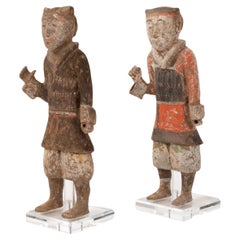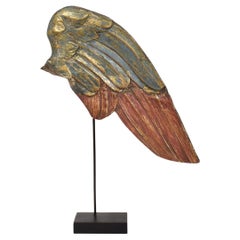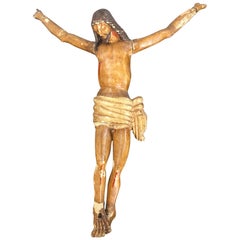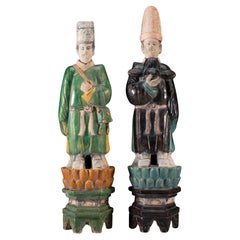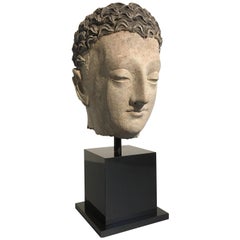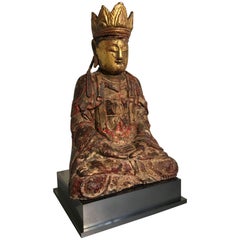18th Century and Earlier Figurative Sculptures
to
218
1,146
1,146
3,753
9,075
2,751
2,267
3,206
2,041
303
151
564
562
255
490
565
671
386
268
217
111
63
14
14
10
6
2
1
620
250
249
212
106
592
484
821
375
175
145
104
Height
to
Width
to
1,146
1,146
1,146
67
28
20
9
7
Period: 18th Century and Earlier
Pair of Terracotta Han Guards in Polychrome Paint China Han-Dynastie, TL Tested
Located in Salzburg, AT
Pair of terracotta Han guardsmen in polychrome paint China TL tested
Pair of rare standing male terracotta sculptures/warriors of the Chinese Han dynasty from the 2nd century BC.
W...
Category
Chinese Han Antique 18th Century and Earlier Figurative Sculptures
Materials
Terracotta, Acrylic
Large 18th Century, Italian Carved Wooden Wing of a Baroque Angel
Located in Buisson, FR
Beautiful large Baroque angel-wing with its original color and gilding. Extremely rare to find in this size.
Very decorative item placed on a wooden base.
Italy, circa 1750. Weathere...
Category
Italian Baroque Antique 18th Century and Earlier Figurative Sculptures
Materials
Wood
$685 Sale Price
50% Off
18th Century Carved Wooden Representing Christ on the Cross
Located in Miami, FL
Carved wooden representing Christ on the cross.
Category
Spanish Neoclassical Antique 18th Century and Earlier Figurative Sculptures
Materials
Wood, Paint
Tall Ming Dynasty Sancai Glazed Dignitary Tomb Figures
Located in Dallas, TX
A Pair of Chinese Enameled Sancai Glazed Pottery Attendant Figures Representing Dignitaries.
Ming Dynasty Period. Circa 1600AD
Dimensions; 23 x 5.5 x 5.25 inches (58.4 x 13.7 x 13.3 ...
Category
Chinese Ming Antique 18th Century and Earlier Figurative Sculptures
Materials
Pottery
Gandharan Stucco Head of the Buddha, 3rd-5th Century
Located in Austin, TX
A sublime Greco-Buddhist stucco head of the Buddha, ancient region of Gandhara, circa 3rd-5th century.
A fragment of a larger statue, the Buddha's face...
Category
Pakistani Antique 18th Century and Earlier Figurative Sculptures
Materials
Stucco
Chinese Ming Dynasty Carved, Painted and Giltwood Amitayus Buddha
Located in Austin, TX
A beautiful and serene Chinese Ming dynasty carved wood figure of the Buddha Amitayus, the Buddha of long life, and a form of Amitabha Buddha. He is seated in dhyanassana, dressed in...
Category
Chinese Ming Antique 18th Century and Earlier Figurative Sculptures
Materials
Wood
18th Century Italian Silver and Gold Crucifix with Mica and Calcite Crystal
By Interi
Located in Dublin, Dalkey
18th century Italian silver and gold leaf crucifix adorned with baroque pearls and mounted on a mica cluster and a calcite crystal. The mica specimen is from the Great Smoky Mountain...
Category
Italian Rococo Antique 18th Century and Earlier Figurative Sculptures
Materials
Rock Crystal, Gold Leaf, Silver Leaf
Ancient Greek Terracotta Antefix in Form of the Head of Artemis Bendis, Taranto
Located in Antwerp, BE
Ancient Greek mould-made terracotta antefix decorated with the female head of the Goddess Artemis Bendis.
Western Greek, Italy, Taranto, early 4th century BC.
Two small feathered win...
Category
Italian Classical Greek Antique 18th Century and Earlier Figurative Sculptures
Materials
Ceramic
Italian 18th Century Hand Carved Wooden Baroque Angel Fragment
Located in Buisson, FR
Beautiful hand carved Baroque angel fragment. Unique period piece with traces of its old color .
Italy, circa 1750
Weathered. small losses.
Measurement here below includes the wood...
Category
Italian Baroque Antique 18th Century and Earlier Figurative Sculptures
Materials
Wood
$886 Sale Price
44% Off
Portuguese Baroque Madonna and Child Sculpture, 17th Century
Located in Lisbon, PT
This late 17th-century Portuguese Baroque sculpture in polychromed wood depicts the Madonna holding the Christ Child, carved with exquisite detail and spiritual grace.
The Virgin is...
Category
Portuguese Baroque Antique 18th Century and Earlier Figurative Sculptures
Materials
Gold Leaf
$17,599 Sale Price
20% Off
Small Song Dynasty Carved Wood Bodhisattva, 13th Century, China
Located in Austin, TX
A small and very fine Chinese carved sandalwood figure of a bodhisattva, possibly Avalokiteshvara (Guan Yin), Song Dynasty (960 to 1276), circa 13th ...
Category
Chinese Antique 18th Century and Earlier Figurative Sculptures
Materials
Hardwood
Early Spanish 17th C. Porto Santos with Original Polychrome Paint and Columns
Located in Round Top, TX
Very rare and early Spanish Porto Santos “Door of the Saints” Altarpiece with 12 carved columns and original gilt and polychrome paint. This is typical piece to be seen in the Cathol...
Category
Spanish Antique 18th Century and Earlier Figurative Sculptures
Materials
Wood
Hellenistic Grotesque Theatre Mask of Maccus
Located in London, GB
Grotesque theatrical mask of Maccus
Late Hellenistic or Early Imperial period, circa 1st century B.C. – 1st century A.D., likely from Southern Italy.
Terracotta with remains of pin...
Category
Italian Classical Roman Antique 18th Century and Earlier Figurative Sculptures
Materials
Terracotta
Pre-Columbian Standing Male Nude Figure
Located in Astoria, NY
Pre-Columbian Standing Male Nude Figure, probably Aztec, black burnished terracotta, mounted on ebonized wood base. 14.5" H x 7" W x 4.5" D. Provenance: From an Upper East Side Colle...
Category
Central American Pre-Columbian Antique 18th Century and Earlier Figurative Sculptures
Materials
Terracotta
18th Century Italian Cross on a Red Hematoid Quartz Heart with Baroque Pearls
By Interi
Located in Dublin, Dalkey
18th Century Italian cross mounted on a polished red hematoid quartz heart and adorned with natural-forming baroque pearls and a cross-shaped baroque pearl. The piece is inspired by ...
Category
Italian Rococo Antique 18th Century and Earlier Figurative Sculptures
Materials
Quartz, Crystal, Gold Leaf
La Tolita-Tumaco Standing Female Figure
Located in Chicago, IL
This standing effigy was crafted in 500 A.D. - 1000 A.D. Mesoamerica using the gray clay paste that characterizes La Tolita-Tumaco ceramics of early Colombia-Ecuador. The art of La Tolita-Tumaco civilization is considered one of the most developed of the pre-Columbian period as metalwork and ceramics were the most popular form of cultural expression. The ceramic creations of this culture were often based on the human figure to create portraits of people and realistic daily scenes of life cycles and the human condition.
This figure appears to be wearing a loincloth and is adorned with a beaded necklace and an elaborate coiffure or headdress. There are holes lining each ear indicating the potential use of ear spools...
Category
South American Pre-Columbian Antique 18th Century and Earlier Figurative Sculptures
Materials
Ceramic
Egyptian Painted Sarcophagus Mask
Located in Astoria, NY
Egyptian Painted Sarcophagus Mask, gesso over wood composite, mounted on metal base. Overall: 11" H x 7.5" W x 3.75" D. Provenance: From a Fifth Avenue Collection.
Category
Egyptian Egyptian Antique 18th Century and Earlier Figurative Sculptures
Materials
Gesso, Wood
Tang Dynasty Museum Quality TL Tested Terracotta Fat Lady Figure
Located in Dallas, TX
Tang Dynasty painted terracotta fat lady tomb figure
China. Tang Dynasty Circa 618-907
Modelled in the form of a classically dressed fat lady, this terraco...
Category
Chinese Tang Antique 18th Century and Earlier Figurative Sculptures
Materials
Terracotta
Tang Dynasty Fat Lady Pottery Figure
Located in Dallas, TX
Tang Dynasty Terracotta sculpture of a fat lady
This stunning lady wears her hair in an elaborately styled coiffure. A remarkable amount of the original pigm...
Category
Chinese Tang Antique 18th Century and Earlier Figurative Sculptures
Materials
Pottery
Italian Renaissance Carved Wooden Angel Head
Located in Los Angeles, CA
Italian renaissance hand carved wooden "putto" angel head, circa 15th Century
Width 14 inches / height 14 inches / depth 4 inches
1 available in stock in Italy
Order reference #: FAB...
Category
Italian Renaissance Antique 18th Century and Earlier Figurative Sculptures
Materials
Wood
Memento mori sculpture depicting a skull, Italy 1700.
Located in Milan, IT
Wunderkammer Memento Mori sculpture. depicting a skull, carved from a single piece of fruitwood, this sculpture depicts a skull with deliberately exaggerated and distorted proportion...
Category
Italian Antique 18th Century and Earlier Figurative Sculptures
Materials
Wood
Pair of Chinese Ming Sancai Dragon Roof Tiles, c. 1650
Located in Chicago, IL
This incredible pair of sancai-glazed Chinese roof tiles were once installed as part of the elaborate roof of a Ming-dynasty temple or grand courtyard home. Dated to the 17th century...
Category
Chinese Ming Antique 18th Century and Earlier Figurative Sculptures
Materials
Earthenware
Tang Dynasty Museum Fat Lady and Child TL Tested
Located in Dallas, TX
Tang Dynasty polychromed fat lady with child in arm. TL Tested
Terracotta, pottery with traces of orange and green paint
Sui to Tang Dynasty (581-618)
Measures: Height: 20.2 inches (51cm)
Width: 9.45 inches (24cm)
Guaranteed Authentic with corresponding TL Thermoluminescence Test conducted by Artemis Testing Lab Included in the sale of this item.
Condition: Excellent with loss to pinky and wear commensurate of age.
This rare and outstanding ceramic court attendant was made during what many consider to be China’s Golden Age, the T’ang Dynasty. It was at this point that China’s outstanding technological and aesthetic achievements opened to external influences, resulting in the introduction of numerous new forms of self-expression, coupled with internal innovation and considerable social freedom. The T’ang dynasty also saw the birth of the printed novel, significant musical and theatrical heritage and many of China’s best-known painters and artists. The T’ang Dynasty took control in 618 AD, when the Li family seized power from the last crumbling remnants of the preceding Sui Dynasty. This political and regal regime was long-lived, and lasted for almost 300 years. The imperial aspirations of the preceding periods and early T’ang leaders led to unprecedented wealth, resulting in considerable socioeconomic stability, the development of trade networks and vast urbanisation for China’s exploding population (estimated at around 50 million people in the 8th century AD). The T’ang rulers took cues from earlier periods, maintaining many of their administrative structures and systems intact. Even when dynastic and governmental institutions withdrew from management of the empire towards the end of the period – their authority undermined by localised rebellions and regional governors known as jiedushi –the systems were so well-established that they continued to operate regardless. The artworks created during this era are among China’s greatest cultural achievements. It was the greatest age for Chinese poetry...
Category
Chinese Tang Antique 18th Century and Earlier Figurative Sculptures
Materials
Terracotta
Memento Mori in Wood with Chrismon, Monogram of Christ, Italy End of 17th Cent
Located in Milan, IT
A Memento Mori in wood with Chrismon, monogram of Christ. Valuable sculpture in fruit wood in almost true-to-life measurements, sculpted with art and finished with a wealth of details. The wood was covered with a thin layer of pellet and finished in color.
Immediately above the forehead, in correspondence with the anterior neonatal fontanel, the CHRISMON is painted in purple red. The monogram of Christ or Chi Rho (or CHRISMON) is a combination of letters from the Greek alphabet, which form an abbreviation of the name of Christ. Solar in nature, often inscribed in a circle with multiple rays reminiscent of the cosmic wheel deriving from the ancient solar emblems of Egypt. The symbol consists of two large overlapping letters, the 'X' and the 'P'. They correspond, respectively, to the Greek letter '?' ('chi', which reads kh, aspirated) and '?' ('rho', which reads r). These two letters are the initials of the word '???st??' (Khristòs ), the name of Jesus, which in Greek means "anointed" and translates the Hebrew "messiah". On the sides of these two letters, there are very often two others: one 'a' and one '?', alpha and omega...
Category
Italian Antique 18th Century and Earlier Figurative Sculptures
Materials
Wood
Pair of Tang Dynasty Sancai Glazed Tomb Guardians, Zhenmushou, 7th-8th Century
Located in Austin, TX
A fantastic and powerful pair of Chinese Tang Dynasty three-color (sancai) glazed zhenmushou, tomb guardian figures, late 7th or early 8th century. TL t...
Category
Chinese Tang Antique 18th Century and Earlier Figurative Sculptures
Materials
Earthenware
Pair Ming Dynasty Glazed Pottery Dignitary Figures
Located in Dallas, TX
A pair of Ming dynasty sancai blue glazed pottery figures.
Circa 1500 AD Ming Dynasty
I have owned over 250 ming tomb figures including over 80...
Category
Chinese Ming Antique 18th Century and Earlier Figurative Sculptures
Materials
Pottery
Exquisite Polychrome Spanish santo wood sculpture of St. Dominic
Located in Leesburg, VA
Exquisite Polychrome Spanish santo wood sculpture of St. Dominic
Anonymous
ca. 1700; Spain or the Spanish Americas
Polychrome wood
Approximate ...
Category
Spanish Baroque Antique 18th Century and Earlier Figurative Sculptures
Materials
Wood, Paint
Nayarit Pottery Fertility Female Figure With Child
By Nayarit Culture
Located in Dallas, TX
Nayarit Fertility Female Figure With Child
Pre-Columbian, West Mexico, Nayarit,
Ca. 300 BCE to 300 CE.
A seated terracotta female figure from the shaft tomb tradition, shown cradli...
Category
Mexican Pre-Columbian Antique 18th Century and Earlier Figurative Sculptures
Materials
Pottery
Nayarit Chinesco-Style Figure
Located in Chicago, IL
This seated effigy figure was crafted in 300 BC to 300 AD from the ancient Nayarit region of Mexico and was likely used as a ritual or burial offering. The ceramic works of the Chine...
Category
Mexican Pre-Columbian Antique 18th Century and Earlier Figurative Sculptures
Materials
Ceramic
"Nymph and Satyr" by Claude Michel Clodion
Located in Ciudad Autónoma Buenos Aires, C
Sculpture "Nymph and Satyr", made by the author Claude "Clodion" Michel (1738-1814). Made of bronze and patinated in brown. Signed Clodion.
France, CIRCA 1780.
Category
French Rococo Antique 18th Century and Earlier Figurative Sculptures
Materials
Bronze
16th Century Italian Renaissance Carving of a Male Saint
Located in Stamford, CT
16th century Italian carved and polychromed figure of a male saint or prophet with a wonderful presence. Shown holding an open book in his right hand with flames at his feet, mid-16t...
Category
Italian Renaissance Antique 18th Century and Earlier Figurative Sculptures
Materials
Wood
Early Ming Dynasty Chinese Buddha Statue, circa 14th Century
Located in Dallas, TX
A very fine late Yuan to early Ming Chinese terracotta gilt and polychrome painted Buddha figure, he is dressed in thick robes, his hair arranged in ty...
Category
Chinese Ming Antique 18th Century and Earlier Figurative Sculptures
Materials
Terracotta
18th Century Italian Crucifix with Malachite, Calcite, and Raspberry Garnet
By Interi
Located in Dublin, Dalkey
18th century Italian crucifix mounted on green malachite, calcite with fluorite, and raspberry garnet. The piece is adorned with Carnelian pebbles and garnet. The minerals are from a...
Category
Italian Baroque Antique 18th Century and Earlier Figurative Sculptures
Materials
Rock Crystal, Carnelian, Malachite
$3,375 Sale Price
25% Off
Italian 18th/ 19th Century Carved Giltwood Neo Classical Ornament With Birds
Located in Buisson, FR
Beautiful handcarved giltwoodornament depicting two birds.
Italy circa 1780-1820 . Weathered and small losses
Measurements individual and include the wooden base.
H:28,5cm W:56cm D...
Category
Italian Neoclassical Antique 18th Century and Earlier Figurative Sculptures
Materials
Wood
$590 Sale Price
49% Off
French 17/ 18th Century Carved Wooden Baroque Panel Depicting A Saint And Angels
Located in Buisson, FR
Unique panel depicting a Saint figure and Angels. Wonderful layers of its original color,
France, circa 1650-1750 . Weathered, small losses.
Treated against woodworm.
Measurements in...
Category
French Baroque Antique 18th Century and Earlier Figurative Sculptures
Materials
Wood
$565 Sale Price
46% Off
Italian 18th Century Hand-carved Corpus Christi in Original Paint
Located in Houston, TX
Italian 18th century hand-carved Corpus Christi, in original paint, or in some small areas early paint.
Note: Original/early finish on antique a...
Category
Italian Baroque Antique 18th Century and Earlier Figurative Sculptures
Materials
Gesso, Wood, Paint
Figura di Bambin Gesù in Terracotta XVIII Secolo Arte Devozionale Italiana
Located in Milano, MI
Bambin Gesù in Terracotta della fine del 1700 raffigurato in piedi, privo di vesti, sopra una bella base dorata in oro fino. Italia centro-meridionale, risale alla fine del 1700. Il ...
Category
Italian Baroque Antique 18th Century and Earlier Figurative Sculptures
Materials
Terracotta, Giltwood
Immaculate Conception Religious Sculpture, Baroque, 18th Century
Located in Lisbon, PT
An exceptional 18th-century Spanish Baroque sculpture of the Immaculate Conception, carved in chestnut wood and richly polychromed and crowned.
The sculpture retains its vibrant pi...
Category
Spanish Baroque Antique 18th Century and Earlier Figurative Sculptures
Materials
Metal, Gold Leaf, Brass
$41,904 Sale Price
20% Off
17th Century Sandstone Gargoyle on Stand
Located in Vosselaar, BE
A early 17th century French Gargoyle. Gargoyels were originally intented as waterspouts for churches and castles but soon were used as ornamentation. A...
Category
French Baroque Antique 18th Century and Earlier Figurative Sculptures
Materials
Sandstone
Statue sculpture life size antique old Roman Greek stone reclaimed carving decor
Located in Costa Mesa, CA
Antique statue life sized Roman Greek natural stone old sculpture.
The antique statue displayed in this Ad is one of 12 reclaimed life sized limestone s...
Category
French Rustic Antique 18th Century and Earlier Figurative Sculptures
Materials
Limestone
Sculptural 18th Century Italian Figure of Christ on Red and White Crystal Quartz
By Interi
Located in Dublin, Dalkey
Sculptural 18th century Italian figure of Christ and metal sword with large red and white crystal quartz clusters and phantom quartz.
The figure of Christ was originally part of a c...
Category
Italian Rococo Antique 18th Century and Earlier Figurative Sculptures
Materials
Crystal, Rock Crystal, Metal
Tang Dynasty Pottery Lokapala Tomb Figure
Located in Dallas, TX
A wonderful Chinese red clay pottery tomb figure from the Tang Dynasty (618 to 907). Guarding a dignitary or decorated soldier; these figures stood guard for over a thousand years surviving to decorate your home collection of ancient artistic and cultural artifacts. Original Polychromed red and gray paint pigments still present.
Chinese Buddhist guardian statues made of earthenware and pigments, from the Tang Dynasty (618–907 AD), dated to the late 7th to first half of the 9th century.
The foreign facial features of this brilliantly sculpted guardian figure is evidence of the strong Western presence in Tang-dynasty China. Originating in the Lokapala deity of the Buddhist religion, which came to China from the West, this type of armored tomb guardian...
Category
Chinese Tang Antique 18th Century and Earlier Figurative Sculptures
Materials
Terracotta
Mid-18th Century Italian Polychrome & Gesso Santos Figure (Female Saint)
Located in Lincoln, GB
Mid-18th Century Italian Polychrome & Gesso Santos Figure (Female Saint)
This stunning and rare mid-18th century Italian Santos figure depicts a female saint, masterfully carved in ...
Category
Italian Antique 18th Century and Earlier Figurative Sculptures
Materials
Wood
Gandharan Stucco Head of a Bodhisattva, Region of Hadda, 3rd-5th Century
Located in Austin, TX
A striking Gandharan molded stucco head of a male Bodhisattva, tentatively identified as Manjushri, ancient region of Gandhara, probably Hadda or surrounding area, 3rd-5th century.
The Bodhisattva is sculpted of stucco in an idealized manner as a youthful male, with soft and kind features, a benign expression on his face. He wears an elaborate pleated turban wrapped around his head, with two sweeping lobes at the front.
His turban secured on one side by a small image of a roaring lion. The lion may be read as a reference to Manjushri, the Bodhisattva of Wisdom, who is often depicted as riding or subduing a roaring lion, a metaphor for taming the wild thoughts of the mind.
Manjushri gazes outwards in a beatific manner from almond shaped eyes, a gentle smile on his lips. The eyes at different levels when looking at the sculpture head on, indicating the original placement of the head was meant to be viewed at an angle.
Remnants of pigments to the eyes, nose, mouth and ears.
Mounted on a custom black metal stand.
Hadda was an important center of Buddhist learning in the early history of Greco Buddhist Gandhara, and at one time may have housed a bone relic of the historical Buddha, Shakyamuni. The sculpture and architecture of Hadda followed Hellenistic artistic conventions faithfully, leading some scholars to believe the distinct Greco Buddhist style of Gandhara was first developed in Hadda before spreading to the rest of the region.
The kingdom of Gandhara was situated at a crossroads of trade and cultures. Being one of the last remnants of Alexander the Great's Empire, the inhabitants of the Greco-Bactrian Buddhist kingdom preserved Greek culture and heritage for centuries after the decline of the Greek Empire...
Category
Afghan Hellenistic Antique 18th Century and Earlier Figurative Sculptures
Materials
Stucco
15th Century Corpus Christi Wood Sculpture
Located in Stockholm, SE
Rare late 15th century or early 16th century Gothic Corpus Christi wood sculpture. Probably North German or South Sweden. This large Christ sculpture...
Category
German Gothic Antique 18th Century and Earlier Figurative Sculptures
Materials
Wood
Statue sculpture life size antique old Roman Greek stone reclaimed carving decor
Located in Costa Mesa, CA
Antique statue life sized Roman Greek natural stone old sculpture.
The antique statue displayed in this Ad is one of 12 reclaimed life sized limestone statues.
In this specific ...
Category
French Rustic Antique 18th Century and Earlier Figurative Sculptures
Materials
Limestone
Northern Wei Dynasty Painted Terracotta Horse Torso, 386–534 A.D. or Later
Located in Bonita Springs, FL
A sculptural terracotta horse from the Northern Wei Dynasty (386–534 A.D.), featuring the head and torso rendered in a dynamic, upright pose. The surface is richly decorated with swi...
Category
Chinese Primitive Antique 18th Century and Earlier Figurative Sculptures
Materials
Terracotta
Italian 17th/ 18th Century Giltwood Baroque Ornament
Located in Buisson, FR
Beautiful carved giltwood baroque ornament.
Italy, 17/18th century. Weathered and small losses.
Measurement includes the wooden base.
Category
Italian Baroque Antique 18th Century and Earlier Figurative Sculptures
Materials
Wood
$542 Sale Price
53% Off
French Gothic Stone Sculpture – 14th Century
Located in Madrid, ES
Possibly a Noblewoman
Elegant stone sculpture from 14th-century Gothic France, possibly representing a noble lady. The bust features finely carved details in the attire, with attent...
Category
Antique 18th Century and Earlier Figurative Sculptures
Materials
Limestone
$3,863 Sale Price
20% Off
Italian 18th Century Gilded Paper Mache Dove/ Holy Spirit
Located in Buisson, FR
Amazing gilded paper mache dove/ Holy spirit. Beautiful detailed.
The Dove is a symbol for the Holy Spirit inspired by Jesus’s baptism. The dove has been used among many Christian de...
Category
Italian Baroque Antique 18th Century and Earlier Figurative Sculptures
Materials
Paper
$1,066 Sale Price
52% Off
16th Century Southern Germany Carved Wood Bracket Depicting a Mermaid
Located in Saint-Ouen, FR
In Medieval Europe and even more during the early 16th century fantastic beasts could be found in Bestiaries, a literary genre close to poetry. A bestiary used the characteristics of...
Category
German Renaissance Antique 18th Century and Earlier Figurative Sculptures
Materials
Wood
Ancient South Arabian Alabaster Statue
Located in London, GB
South Arabian Calcite female figure
3rd Century BC to 1st century A.D.
Calcite Alabaster
height: 30.5 cm
A magnificent alabaster female figure, a f...
Category
Yemeni Antique 18th Century and Earlier Figurative Sculptures
Materials
Alabaster
18th century polychromed pinewood santos figure/procession mannequin/capipote
Located in Brecht, BE
an extraordinary piece, a very rare find this capipote/santos figure,
lovely carving, wonderful soft expression on the polychromed face, bought from an Italian collector, who had it...
Category
Italian Antique 18th Century and Earlier Figurative Sculptures
Materials
Pine
18th Century Italian Cross with Fossil Agate Coral and Mounted on Fossil Coral
By Interi
Located in Dublin, Dalkey
Sculptural 18th century Italian cross with fossil agate coral and mounted on fossil coral.
The fossil agate coral and fossil coral are put together with the 18th century cross to lo...
Category
Italian Rococo Antique 18th Century and Earlier Figurative Sculptures
Materials
Rock Crystal, Agate, Coral
The Farnese Bull, fragmentary Relief, early 17th Century
Located in Greding, DE
Fragmentary relief from the early 17th century made of marble. The relief is modeled after the Farnese Bull, a Roman colossal sculpture that was excavated in the 16th century and is ...
Category
Austrian Baroque Antique 18th Century and Earlier Figurative Sculptures
Materials
Marble
Roman Marble Foot
Located in London, GB
Roman marble Fragment of a Right Foot with Sandal
Circa 1st - 2nd Century A.D.
An evocative Roman marble fragment, preserving the front portion of an over-lifesized sandalled foot. The toes, nails, and bridge of the foot have been sensitively carved. The outer sole of the sandal remains, with delicate, pointed straps joining between the first two toes in a diamond shape.
This fragment once belonged to Danish sculptor Jens Adolf Jerichau...
Category
Italian Classical Roman Antique 18th Century and Earlier Figurative Sculptures
Materials
Marble
$22,000
18/19th C. Italian Neoclassical Patinated Bronze Sculpture of Bacchus
Located in New York, NY
A Rare and Exquisite Late 18th to Early 19th Century Italian Neoclassical Patinated Bronze Sculpture of Bacchus, God of Wine, Fertility, and Revelry.
This superbly cast and finely m...
Category
Italian Neoclassical Antique 18th Century and Earlier Figurative Sculptures
Materials
Marble, Bronze
18th Century Porcelain Dancing Couple Figurine by Volkstedt
Located in Lisbon, PT
A charming Baroque translucent soft-paste porcelain figurine of a dancing couple of the Volkstedt, Muller & Co, Dresden manufacturing of the late 18th century.
Marked on the base.
Category
German Baroque Antique 18th Century and Earlier Figurative Sculptures
Materials
Porcelain
$640 Sale Price
50% Off
Wood Low-Relief Depicting a Werewolf and Saint George
Located in Saint-Ouen, FR
Exceptional polychrome wood low-relief depicting a werewolf and saint george after a woodcut by lucas cranach (“DER WERWOLF” 1512)
Provenance :
collection Brimo de Laroussihle
colle...
Category
German Renaissance Antique 18th Century and Earlier Figurative Sculptures
Materials
Wood
18th Century Italian Gilded Bird with Calcite Crystal in a Sphalerite Matrix
By Interi
Located in Dublin, Dalkey
18th century Italian hand-carved and gilded bird on a cut phantom calcite crystal base. The missing wing of the bird has been replicated with a rare coordinating calcite crystal clus...
Category
Italian Rococo Antique 18th Century and Earlier Figurative Sculptures
Materials
Quartz, Rock Crystal, Crystal, Gold Leaf
Recently Viewed
View AllMore Ways To Browse
Lucite Head Sculptures
Roman Soldier Bronze Sculpture
Italian Angel Statues
Lead Figurines
Marble Girl Nude
Miguel Berrocal Puzzle Sculptures
Narcissus Bronze
Narcissus Sculpture
Pharaoh Statue
Roman Centurion
Vendome Marble
Vintage Car Mascots
Vintage Mannequin Head
Wood Stump Sculpture
A Fayral
Alcove Sculptures
American Indian Statue
Angels Playing Instruments
